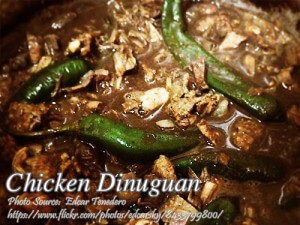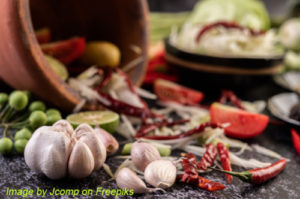Batchoy is a well known Filipino soup and it originates in Ilo-ilo. This version, the batchoy tagalog is one of the variants and this recipe has a unique and authentic flavor because the meat is smoked before cooking, don’t have noodles and with the addition of pork blood. I think this recipe will be a great addition to your menu specially on birthdays or other occasions.
Batchoy Tagalog: A Nostalgic Bowl of Comfort
Growing up in a family of home cooks, I’ve always been drawn to recipes that feel like a warm embrace. One of these dishes is batchoy tagalog, a comforting and flavorful soup that takes me back to the rustic kitchens of my childhood. Unlike its noodle-filled counterpart from Iloilo, this version stands out with its smoky meat, rich pork blood, and vibrant chili leaves. Every time I cook it, I can almost hear my Lola Tessa’s voice, gently guiding me through each step as the aroma of garlic and ginger fills the air.
A Hearty Dish with Deep Roots
When people think of batchoy, their minds often wander to the bustling markets of Iloilo, where the classic noodle soup originated. However, batchoy tagalog has carved its own space in Filipino cuisine, particularly in Southern Luzon. The absence of noodles gives it a lighter feel, but the addition of smoked pork and pork blood creates a depth of flavor that’s hard to forget.
My Uncle Nestor, who grew up in Batangas, introduced me to this version during one of our family reunions. He shared how his mother would cold-smoke the meat on a makeshift grill using local wood chips, giving the dish its distinct taste. That small, ingenious step elevates the entire experience, turning a humble soup into a showstopper.
The Art of Smoking the Meat
One of the most fascinating techniques in making batchoy tagalog is smoking the pork and liver before cooking. Uncle Nestor explained that this technique is called “cold smoking,” where the meat absorbs the smoky aroma without being exposed to high heat. This not only enhances the flavor but also gives the dish a subtle rustic quality that feels like home.
To replicate this, I use a small charcoal grill with a few wood chips and let the magic happen for about an hour. The gentle infusion of smoke makes all the difference. When paired with the savory broth and the richness of pork blood, the result is nothing short of extraordinary.
Cooking the Perfect Batchoy Tagalog
The process of making batchoy tagalog is straightforward, but it requires a bit of patience and love—just as any traditional Filipino dish does. The foundation of its flavor comes from the trifecta of garlic, onion, and ginger sautéed together until aromatic. This step always reminds me of my sister Mel, who swears that the secret to any good soup is letting the onions turn golden brown before moving forward.
Once the smoked pork and liver are added to the wok, they release their juices, creating a natural broth that sets the stage for the bold addition of pork blood. I remember the first time I handled this step—admittedly hesitant—but my mother assured me it’s what makes this dish unique. True enough, it transforms the dish into a luscious, hearty bowl of comfort.
The Finishing Touch
Simmering the meat in water until tender allows all the flavors to meld beautifully. As the soup reaches its final moments, adding green chilies and chili leaves brings a burst of freshness that balances the dish. My cousin Liza loves serving batchoy tagalog in traditional clay pots, which not only keep the soup warm but also add a charming, old-world touch.
For me, this dish isn’t just about the ingredients or the techniques; it’s a bridge to the past, a way to connect with the generations that came before.
Food for Thought
Did you know that the name “batchoy” is derived from the Hokkien word “ba-chui,” which means “pieces of meat”? While the Iloilo version took inspiration from Chinese cooking, this batchoy evolved as a uniquely Filipino creation. Its use of local ingredients like pork blood and native chilies showcases the resourcefulness and creativity of our cuisine.
Whether served during birthdays, fiestas, or quiet Sunday lunches, this dish has a way of bringing people together. My family’s kitchen, noisy with laughter and clinking utensils, is proof of that. And isn’t that what Filipino food is all about—celebrating life’s moments, big or small, with dishes that warm the soul?
Batchoy Tagalog Is A Dish Worth Trying
Cooking batchoy tagalog at home is an experience in itself. From the aroma of the smoked meat to the vibrant colors of the finished dish, every step feels like a celebration of Filipino heritage. If you’re new to Filipino cooking, don’t be intimidated. This recipe is forgiving and will reward you with a rich, hearty soup that’s as satisfying to make as it is to eat.
So the next time you’re looking for something special to add to your menu, why not give it a try? Trust me, it’s one of those recipes that feels like a hug in a bowl—perfect for rainy days, family gatherings, or simply reconnecting with our roots.
Who knows? It might just become a favorite in your kitchen, too.
How to Cook Batchoy Tagalog (Filipino Pork and Liver Soup)
Ingredients
- 1 kilo lean pork
- 1/2 kilo pork liver
- 1 cup fresh pork blood
- 1/4 cup crushed ginger
- 1 head garlic crushed
- 2 pc medium sized onion
- 1/2 cup patis or fish sauce
- 5 pcs long green chilies siling pangsigang
- 1 cup bird eye chili leaves dahon ng siling labuyo
Instructions
How to cook batchoy tagalog:
- Light up a small amount of charcoal and wood chips in a grill with cover.
- Smoke the pork and the liver. Use cold smoke technique for this dish.
- Smoke for at least one hour. Cut smoked pork and liver into strips. Set aside.
- In a wok, saute garlic, onion and ginger at the same time.
- Stir fry for a few minutes until the onion is cooked and turns brown.
- Add the pork and liver and stir fry for a few minutes until broth comes out of the meat.
- Pour the fresh pork blood and season with fish sauce.
- Mix for a while until all the ingredients are covered with pork blood.
- Cover the wok and cook until all the liquid evaporates.
- Then transfer all the meat contents of the wok to a big heavy pot that can hold about 5 liters of liquid.
- Pour 4 liters of water in the pot and cover. Simmer for at least 30 minutes or until the meat is tender.
- Then add the green chilies and chili leaves and turn off the fire immediately.
- The heat of the dish will cook the chili and the leaves so it will look presentable and not overcooked.
- You can serve it on a clay pot to make it a more authentic Filipino cuisine.
Notes
Cooking Tips:
Master the Art of Smoking the Meat
Smoking the pork and liver is crucial for achieving the distinct smoky aroma of this dish. Use a grill with charcoal and wood chips, and ensure it’s set up for cold smoking, where the meat is exposed to smoke without direct heat. This step infuses a subtle depth of flavor into the meat, setting the foundation for an unforgettable dish.Handle Pork Blood with Care
Fresh pork blood is key to the rich and hearty flavor, so make sure to source it from a trusted butcher. Mix it well to ensure it coats the meat evenly, as this step is essential for building the dish’s signature taste. Cook it thoroughly to balance its earthiness and give the broth its velvety texture.Add the Chili Leaves Last
For a vibrant and fresh finish, always add the green chili leaves just after turning off the heat. The residual warmth from the broth will cook them gently, preserving their bright color and delicate flavor. Overcooking the leaves can make them wilt and lose their appeal, so timing is everything in this final step.






(Edited and corrected version)
Batchoy Tagalog is not a variant of La Paz Batchoy. They evolved and developed independently of each other. .When we (our family) cook batchoy Tagalog we use fatty cut of pork and we also add pork heart,, pork kidneys, pork spleen, pork pancreas and a little amount of pork blood and/or congealed pork blood and not just pork liver. It is like a cross between pork tinola and an anemuc pork dinuguan.and it is somewhat oily. And this is where the Tagalog street slang “tabatsoy or tabachoy came from meaning someone who is chubby or fat (but not morbidly obese) ….usually used to refer to a chubby kid.
HI Jojo, thanks for that informative comment!
This is a great batchoy recipe I found! Quite savory because of the smoked meat.
Hi Gary, the extra effort of smoking the meat is rewarding.